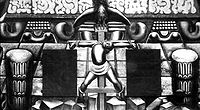America Tropical: Difference between revisions
No edit summary |
No edit summary |
||
| (5 intermediate revisions by 2 users not shown) | |||
| Line 1: | Line 1: | ||
====Date: [[:Category: | ====Date: [[:Category:1932|1932]]==== | ||
====Region: [[:Category:North America|North America]]==== | |||
====Subject: [[:Category:Political/Economic/Social Opinion|Political/Economic/Social Opinion]]==== | |||
====Medium: [[:Category:Public Art|Public Art]], [[:Category:Painting|Painting]]==== | |||
====Medium: [[:Category:Public Art|Public Art]] [[:Category:Painting|Painting | |||
---- | ---- | ||
[[File:America_tropical.jpg|right|200px|thumb|Highly contested portion of mural]] | |||
'''Artist:''' David Alfaro Siqueiros | '''Artist:''' David Alfaro Siqueiros | ||
'''Confronting Bodies:''' Bavarian Beer Garden owners | '''Confronting Bodies:''' Bavarian Beer Garden owners | ||
'''Dates of Action:''' 1932 | '''Dates of Action:''' 1932 | ||
'''Location:''' Olvera Street, Los Angeles, CA | |||
'''Description of Artwork:''' The Los Angeles mural was commissioned to decorate the wall of a Bavarian beer garden on the theme "tropical America." Prominent civic leaders including Otis Chandler were transforming the area around Olvera Street into a quaint reproduction of an idealized Mexican village, and they apparently expected Siqueiros to produce an idyllic panorama of nature and happy laborers. Instead he painted an indigenous man nailed to a cross above which an American eagle perches triumphantly. | |||
'''The Incident:''' Horrified owners of the beer garden quickly whitewashed a portion of the mural, and a couple of years later the rest was also painted over. In the 1970s, the whitewash faded and the mural was visible again. | |||
'''The Incident:''' Horrified owners of the beer garden quickly whitewashed a portion of the mural, and a couple of years later the rest was also painted over. In the 1970s, the whitewash faded and the mural was visible again. | |||
'''Results of Incident:''' In recent months conservators have removed the whitewash, but they have decided against restoring the original colors. Instead they plan to build an interpretive center where visitors will be able to see a half-size reproduction of the mural as it originally looked. It is scheduled to open at the beginning of 2004. | |||
In the summer of 2006, the Getty Trust announced their plan to restore and conserve the mural. In addition to the restoration of the work, the Getty Trust will construct a viewing platform, visitor bridge and an interpretive center for viewers. | |||
''' | '''Source:''' [http://www.nytimes.com/2002/10/29/arts/arts-in-america-a-new-life-for-revolutionary-art.html?src=pm|''The New York Times''], [http://latimesblogs.latimes.com/laplaza/2010/09/america-tropical-mural-siquieros-los-angeles.html|''Los Angeles Times''], NCAC | ||
[[Category:1932]] | |||
[[Category:1930s]] | |||
[[Category:20th century]] | |||
[[Category: | |||
[[Category:]] | |||
[[Category:]] | |||
[[Category:North America]] | [[Category:North America]] | ||
[[Category:United States]] | |||
[[Category:]] | [[Category:California]] | ||
[[Category:Los Angeles]] | |||
[[Category:]] | |||
[[Category:Political/Economic/Social Opinion]] | [[Category:Political/Economic/Social Opinion]] | ||
[[Category:Public Art]] | [[Category:Public Art]] | ||
[[Category:Painting]] | [[Category:Painting]] | ||
[[Category:David Alfaro Siqueiros]] | |||
__NOTOC__ | |||
{{DISPLAYTITLE:<span style="font-style: italic;">America Tropical</span>}} | |||
Latest revision as of 20:36, 3 August 2011
Date: 1932
Region: North America
Subject: Political/Economic/Social Opinion
Medium: Public Art, Painting
Artist: David Alfaro Siqueiros
Confronting Bodies: Bavarian Beer Garden owners
Dates of Action: 1932
Location: Olvera Street, Los Angeles, CA
Description of Artwork: The Los Angeles mural was commissioned to decorate the wall of a Bavarian beer garden on the theme "tropical America." Prominent civic leaders including Otis Chandler were transforming the area around Olvera Street into a quaint reproduction of an idealized Mexican village, and they apparently expected Siqueiros to produce an idyllic panorama of nature and happy laborers. Instead he painted an indigenous man nailed to a cross above which an American eagle perches triumphantly.
The Incident: Horrified owners of the beer garden quickly whitewashed a portion of the mural, and a couple of years later the rest was also painted over. In the 1970s, the whitewash faded and the mural was visible again.
Results of Incident: In recent months conservators have removed the whitewash, but they have decided against restoring the original colors. Instead they plan to build an interpretive center where visitors will be able to see a half-size reproduction of the mural as it originally looked. It is scheduled to open at the beginning of 2004.
In the summer of 2006, the Getty Trust announced their plan to restore and conserve the mural. In addition to the restoration of the work, the Getty Trust will construct a viewing platform, visitor bridge and an interpretive center for viewers.
Source: The New York Times, Los Angeles Times, NCAC
